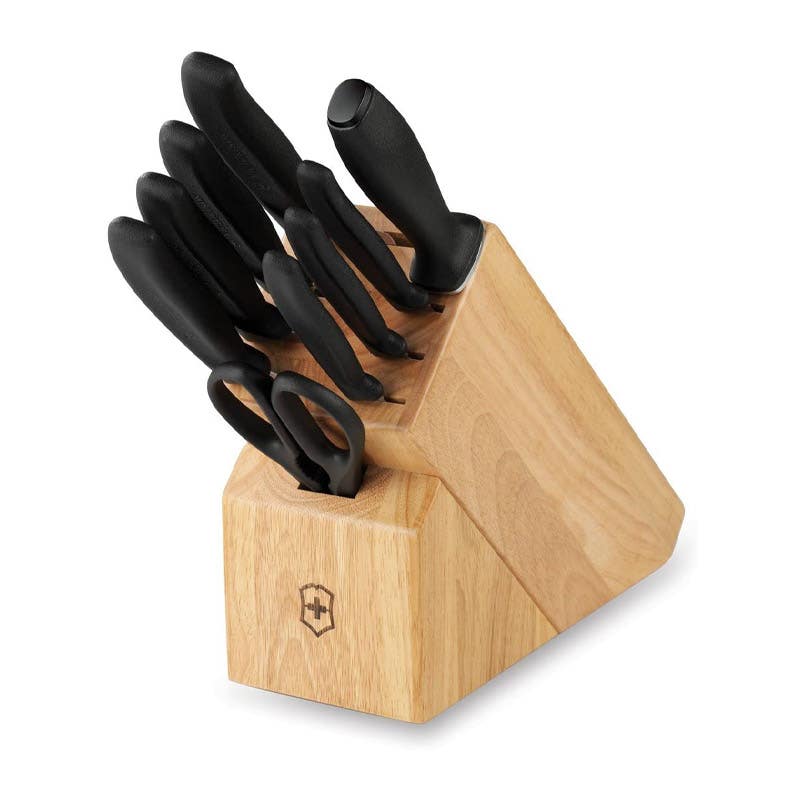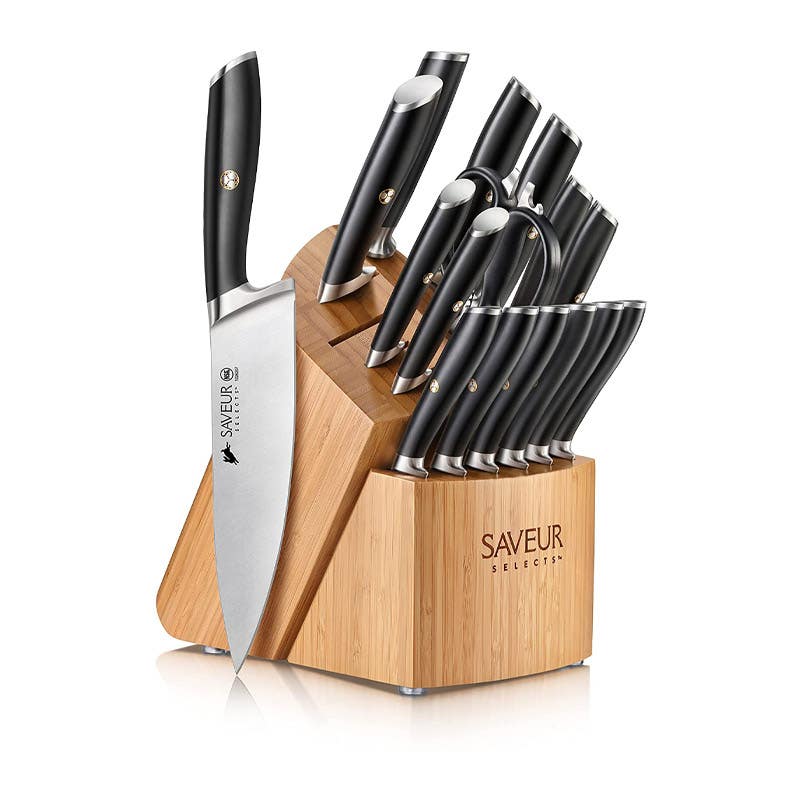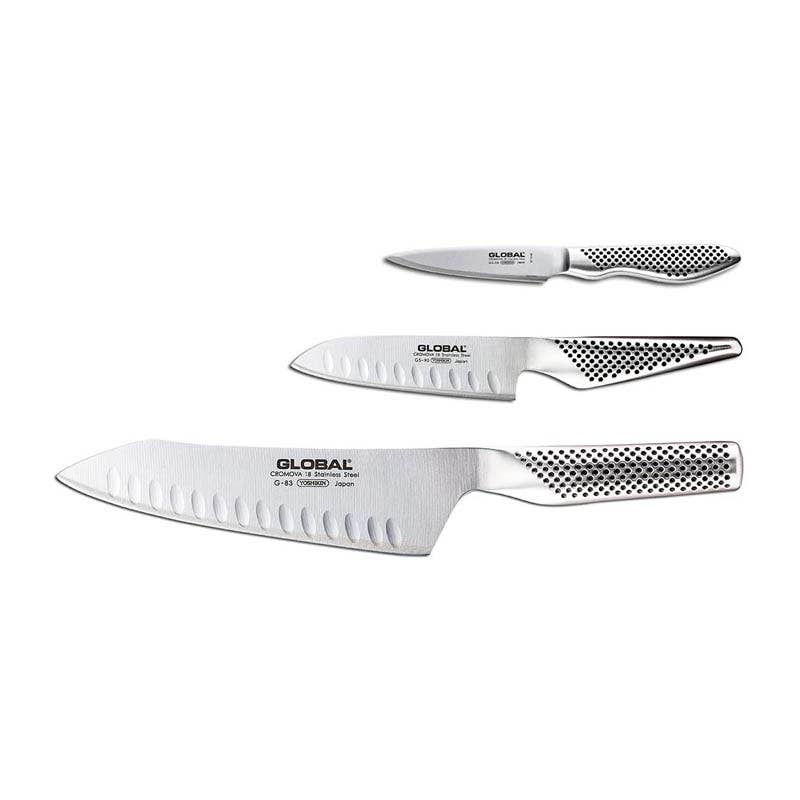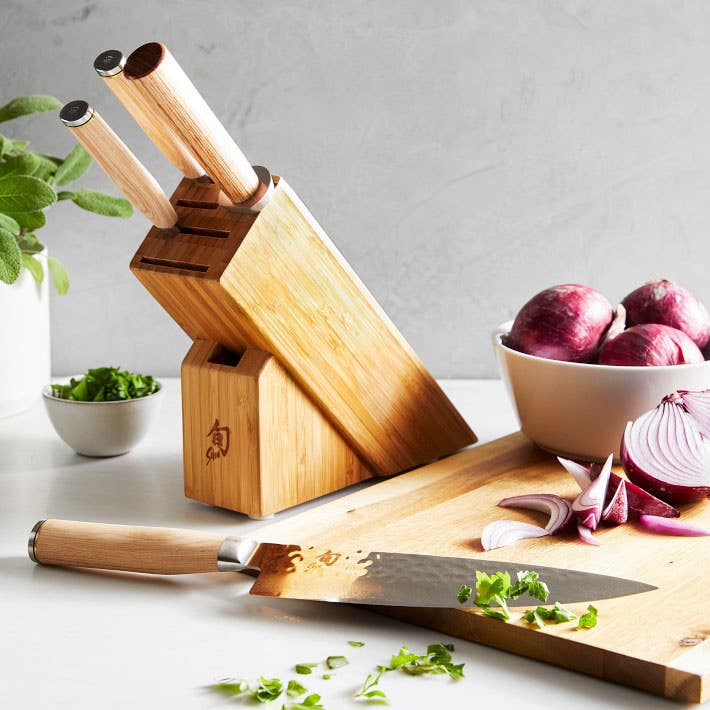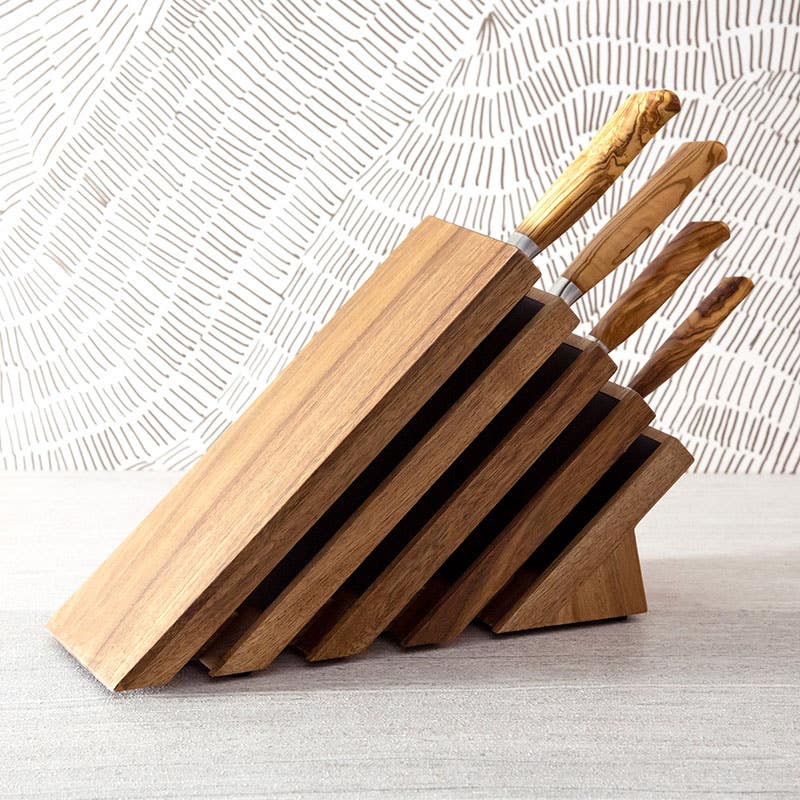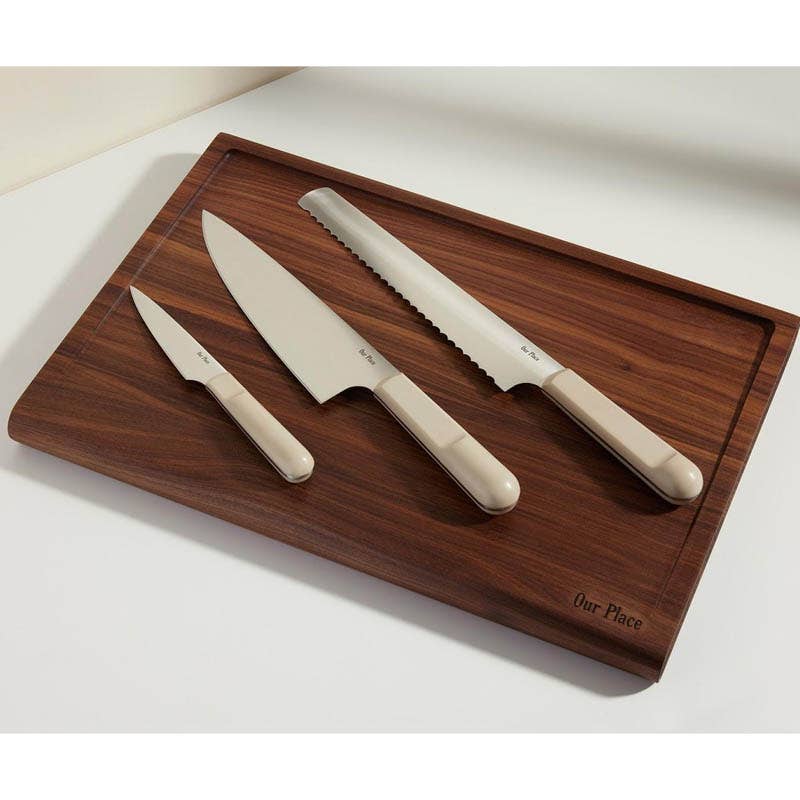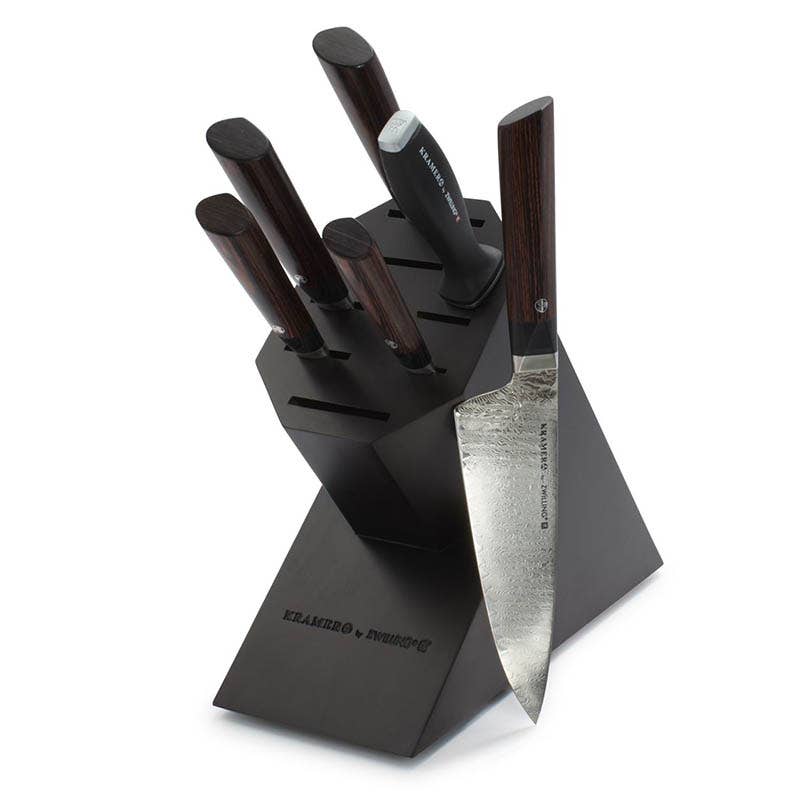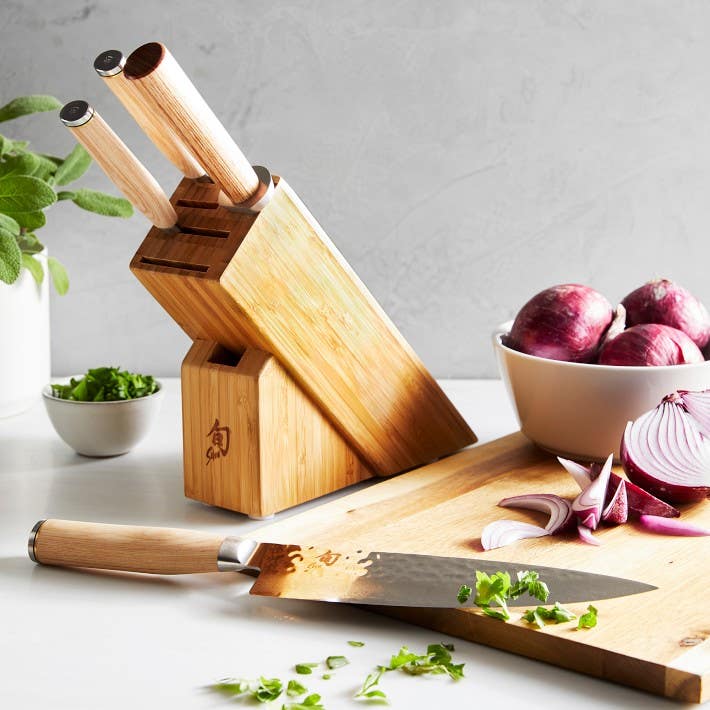
Most chefs and food professionals will tell you it’s best to buy kitchen knives one by one, cherry-picking each for specific tasks. But if you’re a home cook looking to outfit an entire kitchen in one swoop or start fresh without months of shopping, consider the knife set. It’s the simplest route to dicing onions and slicing meats smoothly, and often less costly, too.
Most start with the essential trinity— chef’s knife, paring knife, and serrated knife— but some expand onward and upward to include handy tools like poultry shears and attractive knife blocks. Read on for our expert-sourced guide to the best knife sets for every kitchen.
Our Top Picks
- Best Overall: Victorinox Swiss Classic Knife Block Set
- Best Value: Saveur Selects Knife Block Set
- Best Small Set: Global Classic Knife Set
- Best Japanese Steel Set: Shun Premier Blonde Knife Block Set
- Best German Steel Set: Messermeister Olivia Elite 5 Next Level Block Set
- Best Starter Set: Our Place Knife Trio
- Best Professional Grade: Zwilling J.A. Henckels Kramer Knives Meiji Set
Best Overall: Victorinox 10-Piece Swiss Army Classic Knife Block Set
Best Overall
Victorinox’s 10-piece stainless steel offering is the Toyota Camry of knife sets: not too fancy, well-made, and well-suited for everyday use. The wallet-friendly set includes paring, chef’s, utility, boning, and bread knives. There’s also a honing steel to keep knives straight and sharp, kitchen shears for snipping duties, and a hardwood block for safe storage. Nobody will ooh and ahh over the plain black plastic textured handles and non-forged steel, but the 4.7 out of 5 star rating (from 779 Amazon reviews!) speaks for itself.
Best Value: Saveur Selects 17-Piece Knife Block Set
Best Value
Sometimes more is just more. If you’re looking for a set with even more chops than our best pick above, the 17-piece Saveur Selects set (designed by yours truly) has an armory of options worthy of a Game of Thrones episode. And thank goodness this collection comes with its own bamboo block because that’s a lot of knives to keep stored. Each full-tang knife—a knife made with one continuous piece of metal that extends from the tip of the blade and all the way to the butt of the handle—is crafted from extremely hard and durable German steel, which has been hand-sharpened to a 16-degree edge. With care, this set should last a lifetime. And with this many knives at your disposal, let’s be honest, you’ll likely never need to buy another knife ever again.
Best for Small Kitchens: Global Classic 3-Piece Knife Set
Best for Small Kitchens
These were the first legit knives we purchased decades ago, and we still own the same set today. Global knives are easily identifiable, thanks to a unique stainless-steel construction spanning from the tip of the blade all the way to their dimpled handles as a single continuous shape. The iconic design has remained unchanged since its introduction in 1985. We’ve always loved Global knives for their dependably sharp edge, comfortable textured grip, and great balance. This 3-piece set is priced as an excellent starter kit that includes the essentials—6-inch Chef's Knife, 6-inch Serrated Utility Knife, and 3-inch Paring Knife—each at lengths friendly for use and storage within small kitchens.
Best Japanese Steel Set: Shun Premier Blonde 5-Piece Knife Block Set
Best Japanese Steel Set
Shun knives carry a certain cachet. They’re undeniably beautiful, with light blonde Pakkawood handles capped in an embossed stainless-steel cap that subtly announces your discriminating taste in kitchen instruments. Each Japanese knife also shows off the tell-tale signs of tsuchime, hand-hammered dimpling across the length of each forged blade. Shun’s proprietary VG MAX steel results in a slightly harder and more durable edge compared to other high-quality Japanese style knives. Shun knives normally cost a pretty penny, so this 5-piece William Sonoma exclusive is a respectable bargain (that even includes a free in-store knife sharpening).
Best German Steel Set: Messermeister Olivia Elite 5 Next Level Block Set
Best German Steel Set
Messermeister still crafts each blade using a traditional (and time consuming) hot-drop and hammer forge technique that literally pounds pieces of steel into submission down to the molecular level. The resulting hand-forged blades are heavier, stronger, and better balanced than their machine stamped counterparts. You’ll notice the difference every time you pick up a Messermeister, with its thicker spine running along the full tang blades. And can we talk about that striking angled storage block? It’s a statement piece that’s both stylish and utilitarian—and might earn even more attention than the knives themselves.
Best Starter Set: Our Place Knife Trio
Best Starter Set
You may have already seen this Instagram-favorite cooking brand in your feed, but we were pleasantly surprised to discover Our Place’s three knife set isn’t a case of style over substance. Made with German stainless steel, these full-tang blades have soft indented grips that are friendly for smaller hands. The lightweight, beginner-friendly set is perfect for a college graduation or housewarming gift.
Best Professional Grade: Zwilling J.A. Henckels Meiji 7-Piece Block Set
Best Professional Grade
Of all the tools in our kitchen, there’s nothing we reach for more than a 6-inch chef’s knife designed by American bladesmith Bob Kramer, "widely considered the greatest American knifesmith working today." Our Kramer-crafted knife retains its edge twice as long as anything else we own, with an unrivaled balance across blade to handle that always makes the knife feel like an extension of our hand, whether we’re chopping potatoes, slicing fish, or dicing onions. Kramer’s “East-meets-West design” puts Japanese aesthetics into a Western-style curved blade shape that’s easier to keep sharp than a traditional Japanese blade and also allows you to rock your knife while chopping. It’s made with a steel core clad in 100 layers of nickel and carbon steel, finished with a distinctive whirled Damascus forge pattern.
Features to Keep in Mind When Shopping for a Knife Set
Materials
Stainless steel. Ceramic. High carbon steel. Each material delivers a wickedly sharp edge when brand new. But a knife isn’t judged by its sharpness, rather by how long it keeps that sharp edge with regular use. High carbon steel is considered the best of the three when it comes to keeping an edge. Stainless steel blades are several degrees less durable, but rust resistant. Ceramic knives are extremely sharp and completely immune to rusting, but also more brittle.
Storage
Do yourself a favor: Promise that you’ll never put any knives into the dishwasher or toss them loosely in a drawer where the edge can chip or break. Store them safely in a knife block, or better yet, attached to a magnetic wooden strip.
Sharpening
Unless you like tomatoes smushed instead of sliced, learn how to use a sharpening steel or whetstone to keep your knives honed. The satisfying shhhhhk-shhhhhk sound while sharpening steel will make you feel like a total pro.
If you’re scared to DIY or need to bring a seriously dulled blade back from the brink, help is easy to enlist. Head to a local knife shop, sharpener, or use a mail-in sharpening service. It should cost anywhere between $10-$45 depending upon knife size, style, and the degree of effort required to revitalize the edge.
Ask the Experts
How long will my knife set last?
You really get what you pay for when it comes to knives. Buy a quality forged knife made with high carbon steel or stainless steel, and it’s not unreasonable to expect to be slicing and dicing for decades or even a lifetime with diligent care. A cheap kitchen knife doesn’t just lose its edge quickly; it can also flex or even snap because of the lesser quality materials.
How do I care for my knife set to prolong its life?
Just like keeping your skin healthy, knives deserve a multi-step care regimen to keep them looking and working their finest. You should always clean your knives immediately after every use with warm soapy water with a soft cloth or sponge. It’s especially important to wash and dry knives after cutting acidic ingredients like onions, tomatoes, and citrus; the acid from those foods can corrode steel over time (making ceramic blades a good option for those ingredients). Ward off corrosion from moisture with a protective layer by applying a bit of neutral oil after drying.
What knives do chefs use and recommend?
Chefs are often very particular about their knives and the knife makers they claim allegiance to. But one thing most chefs tend to agree upon is that the average household only needs three knives in the kitchen: a 6-8-inch chef’s knife for cutting meat and slicing or dicing vegetables, a paring knife for peeling fruits and vegetables, and a serrated knife for slicing bread and tomatoes. Everything else is a “specialty knife.”
Keep Reading
Continue to Next Story
